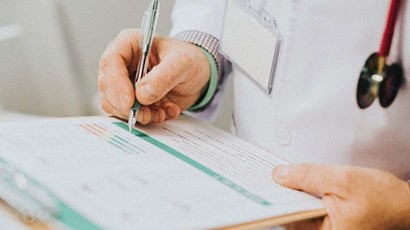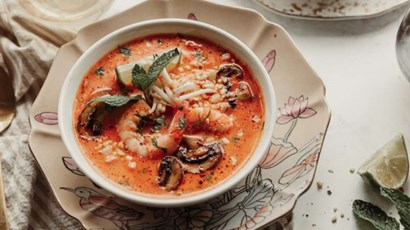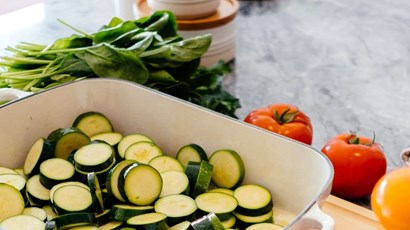Does your wedding menu cater for low cholesterol diets?

Food shopping with high cholesterol
There’s nothing worse than doing the weekly shop when you’re not sure what to put in your trolley – no wonder those with high cholesterol can struggle. But you can turn detective and hunt out the healthy options with our guide to food shopping when you have high cholesterol.
Learn to ‘speak’ food labels
Your first step is figuring out the ‘traffic lights’ on the front of the packaging. You can see at a glance if a portion of food is high (red), medium (yellow) or low (green) in fat, saturates, sugar and salt. As a general rule, choose food with more greens and yellows, and save the reds for occasional treats.
This is very important if there are any reds for saturated fat, as eating too much saturated fat can increase cholesterol levels, especially LDL (the ‘bad’) cholesterol. Women should not eat more than 20 g of saturated fat a day, and men 30 g.
Most traffic light labels will refer to the nutrients in that particular portion of food, rather than per 100 grams, which can make daily diet calculations tricky. Be aware that some packets contain more than one portion of food too, so you could end up eating double the amount of fat, sugar or salt if you eat the whole pack.
It may be more helpful to look at the back of the packaging, where there will be more in-depth nutritional information. This is normally displayed as a grid with data on fat content, saturated fat, carbohydrate, sugars, protein, salt or sodium and calories, often shown as energy in kilojoules (kJ) and kilocalories (kcal). All nutrition information is shown per 100 grams, but sometimes per portion too.
How to lower your cholesterol
Heart attack and stroke may cause 60% fewer deaths in the UK than they did a few decades ago, bu...
Should I avoid anything with fat in?
No, as we need some fat as part of a healthy diet and to help our bodies function properly. But you do need to avoid food that is high in saturated fat if you have high cholesterol. NHS guidelines say something is high in saturated fat if there are more than 5 g per 100 g, and low in saturated fat if there is 1.5 g or less per 100 g.
Something like breakfast cereal or a spread can be high in sugar or fat per 100 g, but you don’t have to cut these out of your diet. ‘If you’re eating something in small quantities, this adds less total fat or sugar to your daily diet than a ready meal or a dessert that has medium amounts of fat or sugar, because you eat a bigger portion of those foods,’ says Linda Main, dietetic advisor for cholesterol charity Heart UK.
The British Heart Foundation also recommends replacing saturated fats with healthy monounsaturated and polyunsaturated fats such as olive, rapeseed or sunflower oils and spreads.
Can I eat eggs and prawns?
For most people, the amount of saturated fat they eat has much more of an impact on their cholesterol than eating foods that contain cholesterol such as eggs, liver, kidneys and shellfish like prawns.
The British Heart Foundation says that unless you’ve been told otherwise by your doctor or dietician, eggs can be included as part of a healthy diet. But if you have an inherited form of high cholesterol, such as familial hypercholesterolaemia, you should be more cautious about eating too much of these foods as they can influence cholesterol levels.
What if there are no labels?
While food packaging can help monitor your nutrient intake, this becomes more difficult when you’re buying loose items such as slices of ham from a delicatessen counter or cakes from a bakery. Don’t be frightened to ask for help though, as many stores will have the nutritional information on individual food items (somewhere).
You could also try using an app - like MyFitnessPal - that contains nutritional information on thousands of everyday foods, as well packaged products, to help you watch what you eat.
Are low-fat and low-sugar foods a good idea?
These can have a place in your diet if you have high cholesterol because they provide healthier substitutes for foods that we all enjoy. However, many low-fat or reduced-fat products use sugar as an alternative to make them taste good.
There is now good evidence that high-sugar, or refined carbohydrate foods, are just as bad for your heart, even if they don’t have the same effect on cholesterol. But you can follow a low-fat and low-sugar diet without having to buy specially produced foods – just cut down the amount of saturated fat and sugar you’re eating.
It’s also a good idea to keep your salt intake down. Salt doesn’t affect cholesterol, but is a major cause of raised blood pressure. The NHS recommends we eat no more than 6 g of salt a day, but this is often labelled as sodium on the packaging. To convert sodium levels into salt, multiply by 2.5 and then divide by 1,000, ie 200 mg of sodium x 2.5 = 500 mg of salt ÷ 1,000 = 0.5 g of salt.
Do cholesterol-lowering foods work?
‘Foods fortified with plant sterols or plant stanols, like margarines, spreads, soft cheeses and yoghurts, have been thoroughly researched and shown to work if taken daily, in the right quantities and as part of a meal,’ says Main. ‘Plant sterols have been shown to bring about 7-12% cholesterol lowering, depending on how much you have. The ideal amount is 1.5-3 g per day, as there’s limited benefit to having more.’
Get help with an app
There are now some great apps available that tell you how much saturated fat, sugar, and salt are in packaged foods. Just scan the barcode with your phone when shopping. Check out the NHS Change For Life Be Food Smart and FoodSwitch UK apps. Both are free for iOS and Android.
Shop all-round healthy
Keeping cholesterol levels balanced is all about healthy eating, so take a whole diet approach rather than concentrating on single foods or nutrients. Go for meals low in saturated fat, based on starchy wholegrains, and with plenty of fruit and vegetables – aim for three portions of veg and two of fruit a day.
Include heart-healthy foods such as nuts, seeds, oily fish, oats, pulses, vegetable proteins (such as soya, Quorn® and pulses), lean meat, vegetable oils and spreads.






